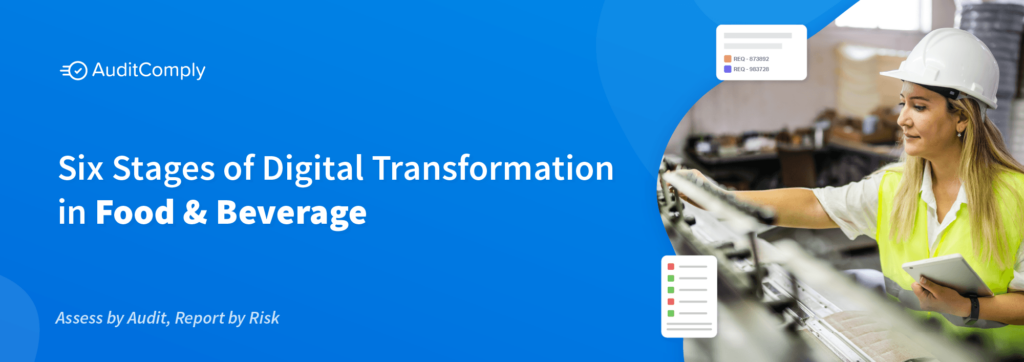
The Importance of Digital Transformation
After years of turmoil, sparked by a global pandemic, conflict in Europe, an ongoing food labor crisis, climate change and an increasingly stringent regulatory environment, the Food & Beverage industry has never experienced so much disruption.
Despite the challenges, food organizations around the world have prevailed, using digital transformation to maintain their resilience in the face of adversity. Not only has digital technology helped food teams adapt rapidly to tough conditions, it’s yielded opportunities to drive future revenue growth and competitiveness.
Research shows that companies conducting digital transformation effectively are winning market share while others are witnessing an increasingly negative ROI in their operations. Undergoing a change to embrace new technologies can seem daunting but the benefits of moving away from manual processes to digitalized solutions far outweigh the burden of undergoing change. Below we have highlighted six key stages of digital transformation as you begin your journey.
Stage 1: ‘The Status Quo’
You may recognize this stage, where thoughts around digital transformation are met with a scowl or lack of urgency. Every corner of your food business is guided by a traditional manual approach; Word & Excel, Pen & Paper, the usual culprits many of you will be familiar with. This process is prone to a lot of misinformation and in the world of Risk, Quality & Compliance, leaving you questioning whether your operations are compliant or if your food product is of the highest quality.

The reason your team sticks with the status quo is usually down to lack of education and long term thinking; the status quo thought process is hindering your food organization’s ability to adapt and grow. Start analyzing your processes, could they be improved? Are they impeding your organization’s ability to meet long term strategic objectives?
Stage 2: Realization
It’s likely at this stage your business is waking up to the importance of digital transformation and how critical it is to your organization’s long term success and development. However, at this stage your understanding of digital transformation is multifaceted, complex and filled with management challenges. Before you start selling the idea of digital transformation, let’s look at the benefits:
-Increases Customer Satisfaction
-Drives Data-Based Insights
-Enables High-Quality User Experience
-Encourages Collaboration & Improves Communication
-Limits Human Error
-Increases Operational Efficiency
-Enables Future Growth
Getting support from your leadership team will be significant for changes to be realized down the line. To do so, you need to understand your “why” and the above benefits to sell this into your organization. Your business might already be feeling the impact of the current climate and be ready for a change. On the other hand, those food organizations that don’t consider the above benefits may be more resistant to change. Consider your approach.
Stage 3: Strategy & Search
If your business has reached this stage, you have managed to work through all the roadblocks and barriers of work culture and executive buy-in, moving towards building a digital strategic roadmap. Departments have recognized the power and strength in digital collaboration and are moving towards investments that will transform the business.
By now you’re starting to structure the building blocks required to implement a new platform. Planning is your vital step to successful digital transformation. However, you need to be agile. There is always a risk to become strict about sticking to a plan, especially when you’ve spent countless hours developing one; digital transformation requires flexibility. Be ready.
Stage 4: Organizational Change

This stage is focused on managing your organization’s shift into the digital era. Successful digital transformation requires focus on both the technology and the people impacted by the change intiative. By leveraging your change management strategy and any third-party assisting the adoption, you need to support individuals through the change process.
Don’t forget, the company culture tends to fall behind process and technology when it comes to digital readiness. Open dialogue is important, not just about the technology involved but also about the process. If done correctly, this digital transformation will influence how the business operates on a culture level, bringing transparency, visibility and accountability, encouraging a more collaborative function.
If you want to break down the barriers, initiate honest conversation about the change and why you’re doing it. The environment you are implementing the change in must be understanding and accepting of the change.
Stage 5: Accelerating Adoption
Organizations that have made it to this step in their digital transformation journey have overcome all the possible roadblocks and are well on their way to success. The implementation has already begun and all the stakeholders involved are happy to be included in the process. Your organization is well-aligned, playing an important role in digital transformation success; objectives are created collaboratively, skills of employees are maximized, leadership is motivated and there is a positive company culture.
Stage 6: Opportunity & Change as a Constant

Finally, you have reached the stage where digital technology is the backbone of your organization. Your food business has shifted from relying on stagnant processes, that have fallen behind the times, to introducing solutions that can bring prosperity.
At this stage in the journey, you will realize there is no end point to this transformation. Digital tools change constantly and rapidly, as do the knowledge and skills necessary to use them. Learning new technological skills is essential for digital transformation. But it is not enough. Employees must be motivated to use these new skills to create new opportunities. They need to build a digital mindset. Transforming how your team reads data, algorithms, and AI, opening up new possibilities and to chart a path for success in a business landscape increasingly dominated by data-intensive and intelligent technologies.
Organizational structures must be continually tuned to make use of new data insights, and leaders must keep working to bring employees along as your food organization continues to evolve.
GRC Digital Transformation & The Future of GRC
AuditComply is a leading Food & Beverage GRC Management platform connecting all aspects of Risk, Food Safety, Compliance and Quality. A platform designed by FSQA & Production Managers to meet the challenges of modern food organizations, from manufacturing to food processing and distribution.
Whether it’s the ongoing labor shortage, requiring you to do more with less, the increasing risk of contamination in the supply chain, or the spiraling complexity of operations, AuditComply delivers a company-wide focus on safety, quality and compliance. Driving reassurance across the industry that your team is delivering the freshest, highest quality, sustainable food products.
If you are curious how AuditComply can help your food business down the path of true digital transformation, learn more from our customers and request a demo today.
